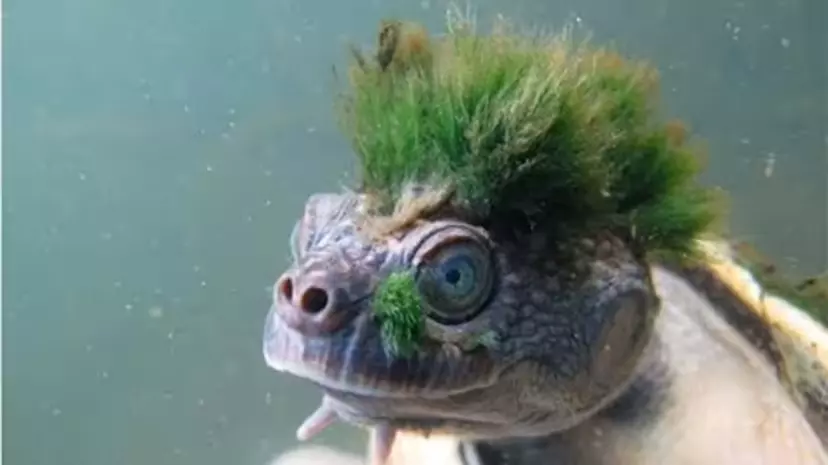Common name: Mary River turtle
Scientific name: Elusor macrurus
Range: Mary River catchment, Queensland, Australia (very small native range)
Status: Listed on ZSL’s first EDGE Reptiles list (Evolutionarily Distinct & Globally Endangered), ranked No. 29
Look: Bright green “mohawk” algae on the head, spiky chin tubercles, long tail, calm demeanor
Party trick: Can stay underwater for days using cloacal bursae (gill-like structures inside the cloaca) for gas exchange

Evolutionary one-off: Many EDGE species are the last representatives of ancient lineages. If the Mary River turtle disappears, there’s nothing closely like it left.
Underwater marathoner: Cloacal respiration lets it hibernate underwater for up to ~3 days at low metabolic rates—without surfacing.
Painfully slow life history: Reaches sexual maturity extremely late (often >20 years). Every adult lost is hard to replace.
Iconic “punk” look: Living in clear, fast, well-oxygenated reaches encourages algal growth on the head and shell, giving that neon-green crest.
Habitat: Clear, cool, well-oxygenated river runs and deep pools with submerged logs, macrophytes, and natural sandbars.
Diet: Primarily aquatic plants/algae, plus some benthic invertebrates.
Reproduction: Females nest on sandy bars and low banks; eggs and hatchlings face heavy predation (foxes, dogs, pigs).
Temperament: Docile, which sadly made juveniles popular in the 1960s–70s pet trade.
Tiny range + ultra-late maturity
Confined to one river system—all eggs in one basket.
Slow recruitment means short-term shocks (poor nesting years, adult losses) have long-term impacts.
Historic collection for pets
Heavy egg/juvenile harvest several decades ago removed future breeders and hollowed out the age structure.
Habitat quality decline
Bank hardening, snag removal, sandbar loss, invasive predators, and altered flows reduce nesting habitat and cover.
Increased sediment and nutrients impair water clarity/oxygen, undermining cloacal respiration and hatchling survival.
Best estimates suggest only low hundreds may remain in the wild—this is a genuinely tiny population.
EDGE (Evolutionarily Distinct & Globally Endangered) combines how unique a lineage is with how threatened it is to set global priorities. Species like the Mary River turtle score high because their evolutionary distinctiveness is irreplaceable.
Nest protection: Predator-proofing (fencing, exclosures), mesh covers, feral predator control, and seasonal buffer zones.
Riverbank restoration: Re-form natural sandbars, reintroduce large woody debris, retain riparian vegetation to cool water and stabilize banks.
Water quality & flow: Cut sediment/nutrient inputs; maintain clear, highly oxygenated reaches with a mix of slow/fast habitats.
Community stewardship: Landholder partnerships for monitoring, rescue, and access; school programs; head-starting and supervised releases where appropriate.
Trade enforcement: Zero tolerance for wild collection; public campaigns to shift demand away from wild turtles.
Long-term monitoring: Mark–recapture, drone/camera nest surveys, eDNA water sampling, and demographic models to track trends.
On the river: Keep off sandbars; don’t dig or handle nests. Report injured turtles or exposed nests to local conservation groups.
At home: Support catchment pollution reduction and riparian plantings; donate to credible Mary River turtle projects.
In the market: Do not buy wild-sourced turtles or products; verify legal, captive-bred origins if acquiring any reptile.
In conversation: Share the turtle’s “punk hair + underwater breathing” story—memorable hooks build public will.
Does it really “breathe through its butt”?
More precisely: it uses cloacal bursae—thin, vascular sacs in the cloaca—for gas and ion exchange. Lungs and skin still matter; bursae extend underwater time dramatically.
Why is slow maturity such a big deal?
Late maturity + low fecundity = slow replacement. Losing a few breeding females can depress the population for decades.
Will captive breeding save it?
It can provide an assurance population, but success depends on disease screening, genetics, and—above all—restored habitat for release.
Will the EDGE listing change anything?
Yes—EDGE gives funders and agencies a quantitative priority signal for unique, highly threatened species, often unlocking targeted support.
animal tags: mary river turtle
We created this article in conjunction with AI technology, then made sure it was fact-checked and edited by a Animals Top editor.